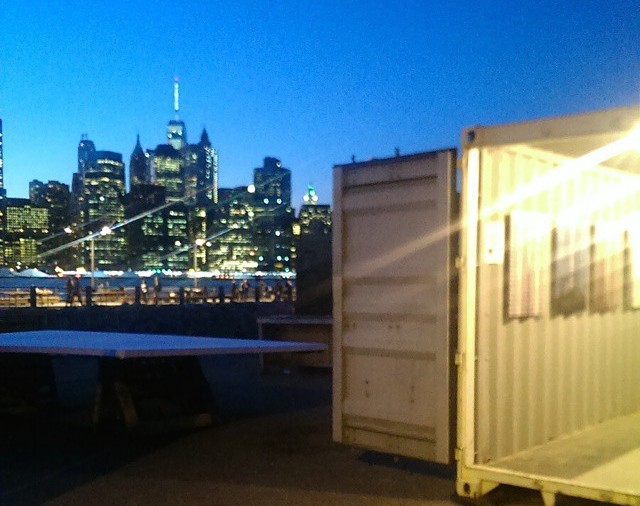“‘The first thirty days after that performance ... it hurt. I just wasn’t right. Whatever that was … catharsis … People don’t understand.’” In the new issue of Harper’s, Wyatt Mason has a moving, in-depth profile of Bryan Doerries, a director and translator who stages classical tragedies for veterans suffering from PTSD. —Lorin Stein
There’s no better way to savor the last of these summer evenings than to head to Photoville, a pop-up photography exhibition in Brooklyn Bridge Park. The exhibition comprises sixty-some shipping containers—surprisingly well suited for the purpose—and, over the course of its eleven-day run, will showcase the work of more than four hundred artists. Highlights include Josh Haner’s Pulitzer Prize–winning series on Jeff Bauman and a curated selection of James Nachtwey’s work from his thirty-year (and counting) tenure at Time. The Photoville runs through September 28. —Stephen A. Hiltner
As I read David Cronenberg’s debut novel, Consumed, I feared I was elevating its somewhat typical techno-thriller plot simply because of the filmmaker’s name. It’s too difficult to sum up here, but the story involves yellow journalism, Marxism, black-market organ trafficking, North Korea, 3-D printing, and sex—the latter “in an incredible number of varieties,” as the jacket states. But I needn’t have worried. Hints of what makes Cronenberg’s filmmaking so unsettling and enthralling began to seep in: the detailed horror of violence and its repercussions, unexpected humor (the Marxist philosophers are named Celestine and Aristide Arosteguy), and the plot’s transition from the tech world to the inner turmoil of our finite existences. As Cronenberg once said, “Consciousness is the original sin: consciousness of the inevitability of our death.” —Justin Alvarez
In this weekend’s Times Magazine, along with John Jeremiah Sullivan’s excellent profile of Donald Antrim, is Matt Bai’s piece about Gary Hart, a name that will fire cobwebbed synapses if you followed presidential politics in ’87. (I didn’t. I was a one-year-old.) Hart was the Democratic front-runner that year until a reporter from the Miami Herald got a tip that he’d been sleeping around. As Bai writes, the Herald’s sanctimonious coverage of these events—or nonevents—has had ramifications not just in the media but in the very essence of our political character. For fear of being crucified as Hart was, politicians no longer do, say, or believe in anything interesting; they’ve purged themselves of personality, conviction, and contradiction. Buried in Bai’s critique is a canny, surprisingly ardent defense of humanism: “As an industry, [the media] aspired chiefly to show politicians for the impossibly flawed human beings they are: a single-minded pursuit that reduced complex careers to isolated transgressions. As the former senator Bob Kerrey, who has acknowledged participating in an atrocity as a soldier in Vietnam, told me once, ‘We’re not the worst thing we’ve ever done in our lives, and there’s a tendency to think that we are.’ That quote, I thought, should have been posted on the wall of every newsroom in the country, just to remind us that it was true.” —Dan Piepenbring
With all the sunshine we’ve been enjoying in New York this September, it seems hard to believe that the autumnal equinox is almost here. As I’m returning to England tomorrow, where it will probably be winter and almost definitely raining, the realization that summer is over is now sinking in. And my mental countdown was only intensified by revisiting Elizabeth Bowen’s The Last September, a novel that centers on Ireland’s Anglo-Irish community during the early twenties, when the War of Independence finally broke through their isolated bubble of tennis and tea parties. Okay, so our situations are not quite analogous. But the magnetism of Bowen’s writing pulls you into a smoldering autumnal landscape that only heats up as the novel progresses, and the Irish rebels close in on “the big house” and its inhabitants. Growing up as an Anglo-Irish child herself, Bowen once remarked that she grew “accustomed to … being enclosed in a ring of almost complete silence.” It’s the breaking of this silence that The Last September captures so well, with those seasonal reds and oranges transforming into warning signs for an inevitable fall. —Helena Sutcliffe
